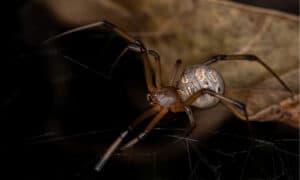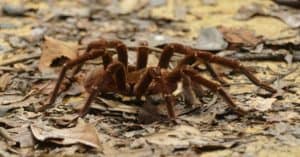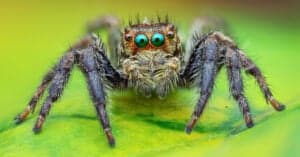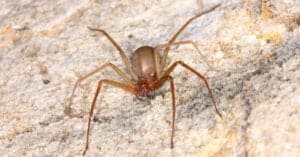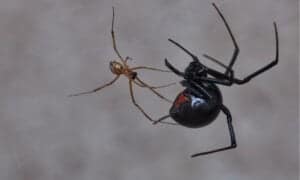10 Spiders in New York
@media (min-width: 481px) {
.mobile-top-content {
display: none;
}
}
#mobileTopContentCTACarouselControls { overflow: hidden; text-overflow: ellipsis; white-space: nowrap; }
.mobile-top-content .more { color: #fff; }
.mobile-top-content a { color: #fff; text-decoration: underline; }
.mobile-top-content a:hover { color: #fff; text-decoration: underline; }
@media (max-width: 480px) {
.mobile-top-content {
background-color: #06a10b;
color: #fff;
text-align: center;
/*height: 60px;
padding-top:5px;*/
font-size:80%;
/* display: block; */
margin: 0px -30px;
}
}
When most people think of New York, they think of New York City and its famous sites; the Statue of Liberty, the Empire State Building, and Madison Square Garden. After all, its nickname is The Empire State, so it’s no wonder that the state is associated with man-made monuments. On the other hand, some people choose to think about the state’s natural beauty. New York is home to many different plants and animals, including bobcats and wild turkeys. The state is also home to many common species of spiders. From orb weavers to fishing spiders, you can find all sorts of arachnids in New York.
Here is a list of 10 spiders in New York that you can find either hiking upstate or on a stroll in the Big Apple.
#10: Black and Yellow Garden Spider

iStock.com/DianaLynne
Argiope aurantia, or the black and yellow garden spider, belongs to the orb-weaver family Araneidae. It is one of the most common spiders in New York and also ranges throughout much of the United States, Canada, and Mexico.
Adult females measure between 19 and 28 millimeters long, while males measure only 5 to 9 millimeters long. They sport characteristic black, yellow, and silver markings on their abdomens, hence their name.
Like other orb weavers, black and yellow garden spiders build large circular webs that they use to capture prey. They spin zigzag shapes into their webs, which is why they also go by the name writing spiders or zigzag spiders. In addition to hunting insects, the females will often eat the males shortly after mating. While they may bite if threatened, their bite is not medically significant.
#9: Northern Yellow Sac Spider
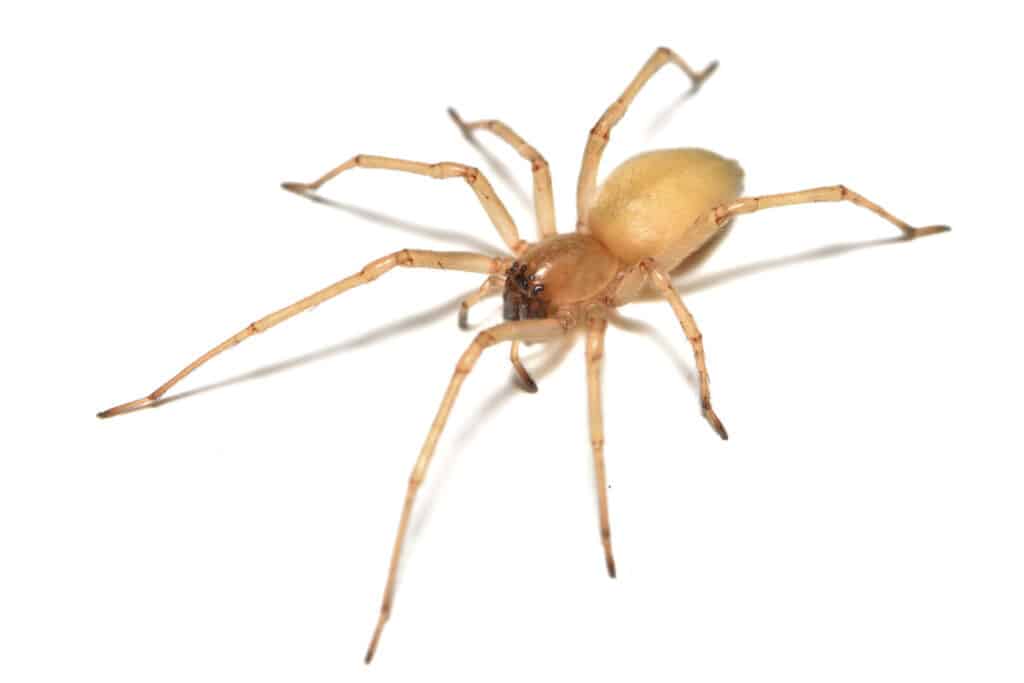
Tobias Hauke/Shutterstock.com
The northern yellow sac spider, Cheiracanthius mildei, belongs to the sac spider genus Cheiracanthium in the family Cheiracanthiidae. You can find northern yellow sac spiders in New York as well as throughout much of the rest of the world.
Adult northern yellow sac spiders range between 7 and 10 millimeters long, with males measuring smaller than females. In terms of appearance, they look predominantly pale green instead of yellow, despite their name. Each leg ends in two claws, and their front legs measure nearly twice as long as their other legs.
Northern yellow sac spiders do not use webs to capture prey. Rather, they are active hunters that emerge at night to pursue prey that wander into their territory. While they don’t use webs to catch prey, they do construct sac-shaped webs that they hide inside to avoid predators. Although they are venomous, their bite poses little danger to humans.
#8: Bowl and Doily Spider

iStock.com/ErikAgar
Frontinella pyramitela is more commonly known as the bowl and doily spider. It belongs to the sheet weaver family Linyphiidae and ranks as one of the smallest spiders in New York. You can typically find it in alpine and tropical forests.
Adult bowl and doily spiders generally measure only 4 millimeters long, with females measuring slightly larger than males. They appear predominantly reddish-brown aside from their legs which have a yellowish hue. Additionally, they sport white dots down each side of the abdomen and short hairs across their bodies.
Bowl and doily spiders build unique webs that they use to capture prey. The web consists of an inverted dome, or bowl, suspended over a horizontal sheet, or doily, hence their name. They hang from the bowl and wait to attack prey that falls into the non-sticky sheet webbing below. Due to their small size, their bite is not medically significant.
#7: Orchard Spider
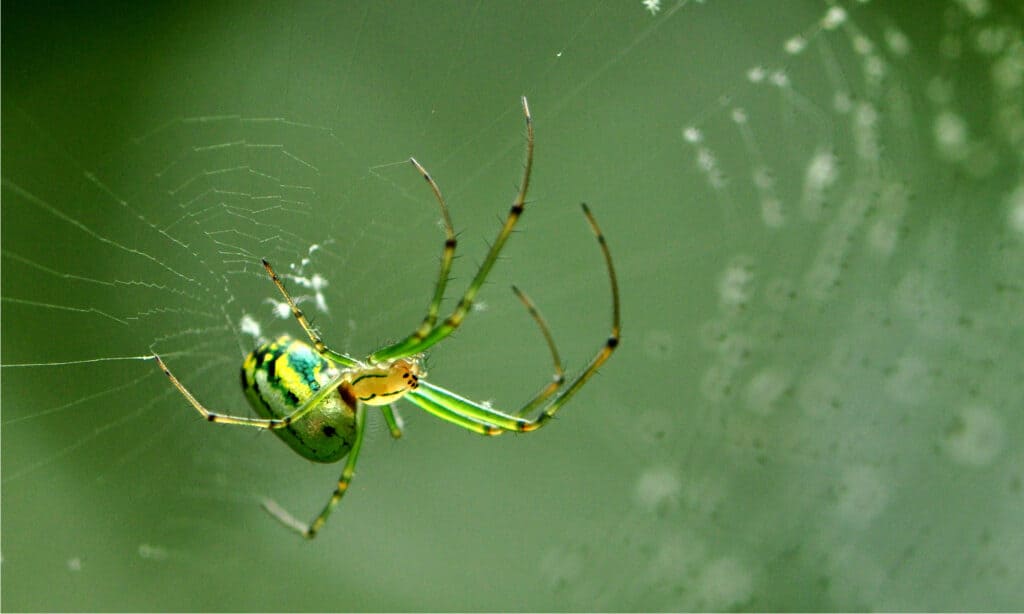
Shelly Jefferson Morton/Shutterstock.com
The orchard spider, Leucauge venusta, belongs to the long-jawed orb weaver family Tetragnathidae. You can find orchard spiders in New York as well as throughout much of the eastern United States.
Adult orchard spiders typically measure from 3.5 to 7.5 millimeters long, with females measuring larger on average than males. Their legs and sides appear leaf-green, while their undersides are covered in black and yellow dots. The top of their abdomen looks primarily silver with black and brown stripes. Additionally, they feature bright orange, yellow, or red spots near the rear of their abdomen.
Orchard spiders frequently hang upside down in the center of their horizontally-oriented webs. They often construct their webs in wooded areas such as orchards, hence their name. Many people consider them beneficial because they prey on garden pests. Furthermore, their bite is not threatening to humans.
#6: Dimorphic Jumping Spider

Justin Starr Photography/Shutterstock.com
Maevia inclemens, or the dimorphic jumping spider, belongs to the jumping spider family Salticidae. Its range extends throughout most of the eastern half of North America.
Adult females measure between 6.5 and 10 millimeters long, while males measure 5 to 7 millimeters long. Females have a light brown cephalothorax, pale legs, and a rust-colored abdomen with a black band on each side. Meanwhile, the males come in two morphs, which is very rare in zoology. One morph has a black body with white legs, while the other has black and white legs and a grey abdomen with orange markings. This dimorphism is the source of the spider’s name and also makes it one of the unique spiders in New York.
Dimorphic jumpers actively hunt a wide variety of insects using their excellent eyesight and agility. Due to their small size, their bite is not medically significant.
#5: Hogna Baltimoriana
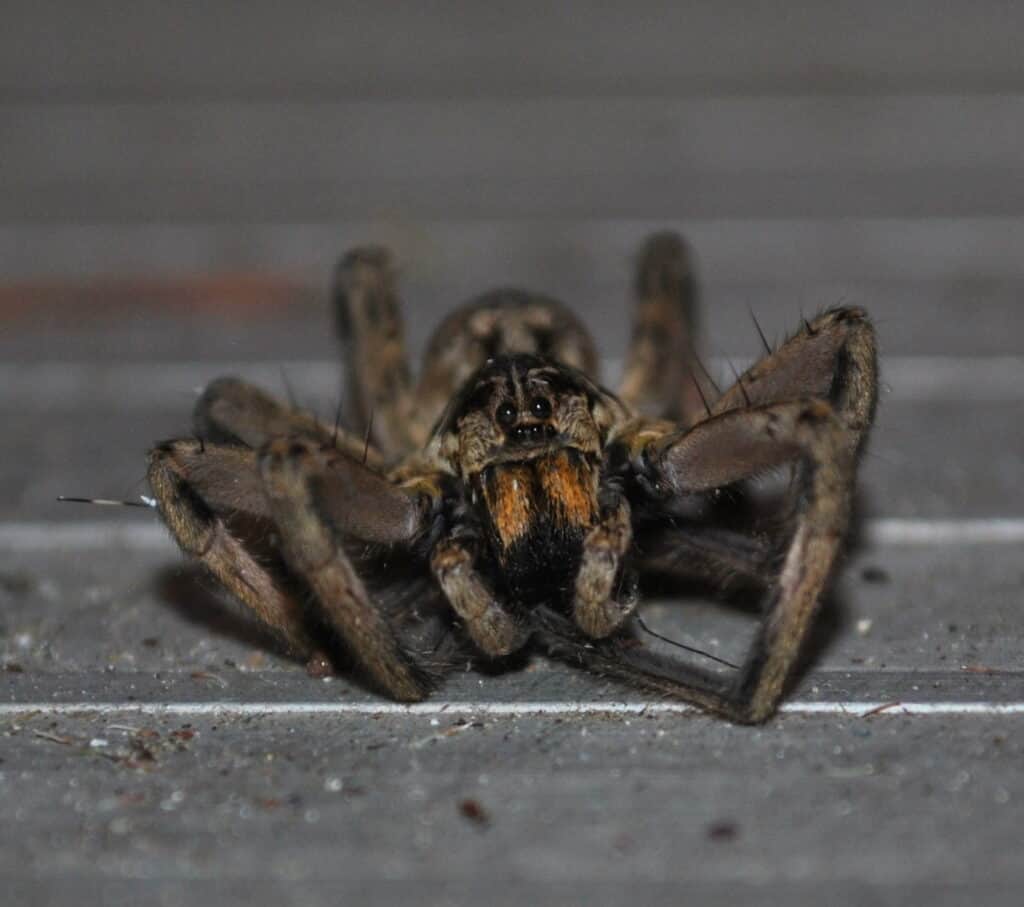
Aaron Carlson / flickr – License
In English, Hogna baltimoriana translates roughly to the Baltimore wolf spider. It belongs to the genus Hogna in the wolf spider family Lycosidae. You can find this spider throughout the United States and Canada.
Adult Hogna baltimoriana specimens measure between 16 to 23 millimeters long, with females measuring larger than males. They appear primarily brown but feature a black cephalothorax and 5 to 6 black chevron markings on the abdomen. Meanwhile, their chelicerae appear dark red or black. Like other members of their family, they possess long, powerful legs that make them quick and powerful runners. You may find a female carrying its eggs on its back during the breeding season.
Hogna baltimoriana does not build a web to catch its prey. Instead, it either ambushes its prey or runs its target down. While its bite is not medically significant, it can be mildly painful.
#4. Deadly Ground Crab Spider

WanderingMogwai / Creative Commons – License
The deadly ground crab spider, Xysticus funestus, belongs to the crab spider family Thomisidae. It is one of the most common crab spiders in New York and is also widely distributed throughout most of the United States, Mexico, and Canada.
Female deadly ground crab spiders typically measure 10 millimeters long. Meanwhile, adult males measure only about half as long. Their bodies appear primarily orange, except for dark markings on the abdomen. They possess long curved legs and can walk forward, sideways, and backward like a crab, hence their name.
Unlike some spiders, deadly ground crab spiders do not use webs to catch prey. Instead, they use their long legs to grab insects that wander too close. Despite their fearsome-sounding name, they pose no danger to humans. At worst, their bite may cause some pain and swelling, which will go away in a few days.
#3. Spined Micrathena
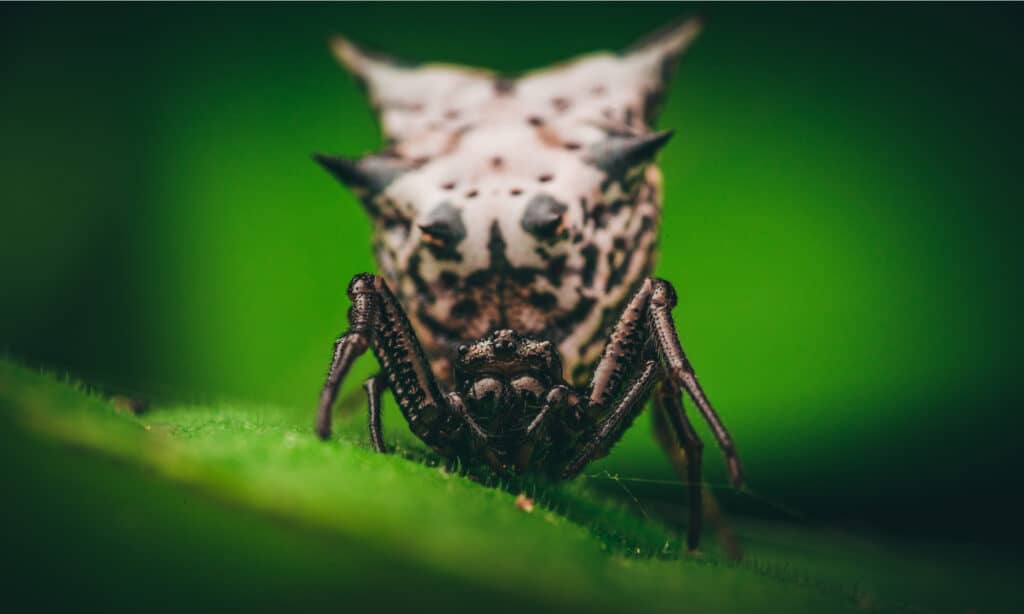
Wirestock Creators/Shutterstock.com
Micrathena gracilis, or the spined micrathena, is the second member of the Araneidae family to make our list of spiders in New York. It also goes by the name the castleback orb-weaver due to its unique appearance. You can find it in neotropical forests throughout North and Central America.
Female spined micrathenas measure 8 to 10 millimeters long, while males measure significantly smaller. The females look predominantly black and white and feature large abdomens covered in spines, hence their name. Meanwhile, the males possess fewer spines and look drabber in appearance.
Like many orb weavers, spined micrathenas repair their webs at night. However, they only repair the inner orb and may leave the outer layer of the web up for days. Additionally, they rarely stay in the same location for long and will often relocate their web after a few days.
#2: False Widow Spider
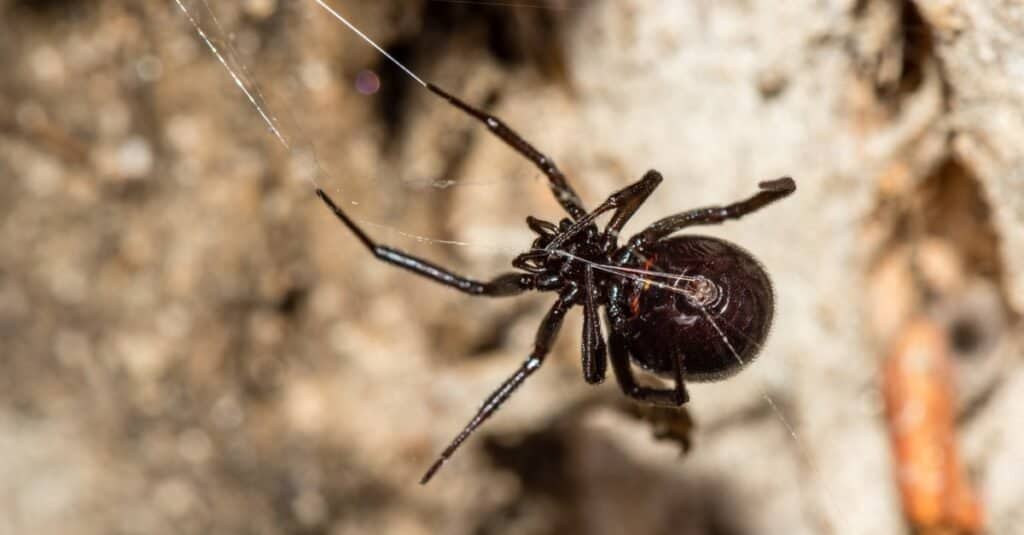
Danie Spreeth Photography/Shutterstock.com
The false widow spider, Steatoda grossa, is one of the most misunderstood spiders in New York. It goes by many other names, including the cupboard spider, dark comb-footed spider, and brown house spider. You can find it throughout most of the world except for Antarctica.
Adult females measure 6 to 10.5 millimeters long, while males measure slightly smaller. They have a round bulbous abdomen and typically appear dark purplish-brown to black. Unlike true widows, they do not feature an hourglass-shaped marking on the abdomen, which allows you to distinguish them from other widows.
Like other members of the cobweb family Theridiidae, the false widow spider builds a cobweb that it uses to capture prey. Due to its poor eyesight, it relies on sensing vibrations in its web to tell when prey is close. While not as deadly as a black widow, its bite can cause pain, muscle spasms, fever, and sweating.
#1. White-Banded Fishing Spider
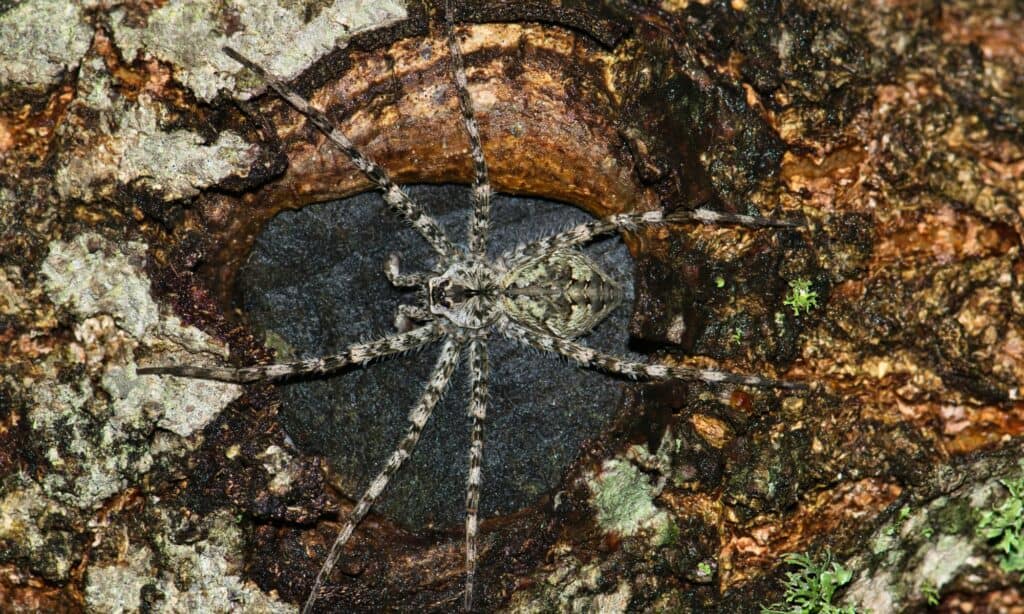
iStock.com/Brett_Hondow
Dolomedes albineus is more commonly known as the white-banded fishing spider. It is a member of the nursery web spider family Pisauridae and one of several fishing spiders in New York. It lives near streams, ponds, and other bodies of water throughout much of the United States.
Adult females can measure up to 23 millimeters long, while males normally max out at around 18 millimeters in length. Although they vary in color, most specimens appear mossy green or brown and possess dark markings. They also feature a white band that runs across the space below their eyes, around the jaws, and sometimes even around the entire carapace, hence their name.
Like other fishing spiders, they actively hunt for insects and other prey that live near or in the water. If necessary, they can run across the surface of the water or dive into the water to catch small fish or tadpoles.
More from A-Z Animals
.more-snake-card-image { max-height:140px !important; }
@media (min-width: 481px) {
.mobile-top-content {
display: none;
}
}
#mobileTopContentCTACarouselControls { overflow: hidden; text-overflow: ellipsis; white-space: nowrap; }
.mobile-top-content .more { color: #fff; }
.mobile-top-content a { color: #fff; text-decoration: underline; }
.mobile-top-content a:hover { color: #fff; text-decoration: underline; }
@media (max-width: 480px) {
.mobile-top-content {
background-color: #06a10b;
color: #fff;
text-align: center;
/*height: 60px;
padding-top:5px;*/
font-size:80%;
/* display: block; */
margin: 0px -30px;
}
}
When most people think of New York, they think of New York City and its famous sites; the Statue of Liberty, the Empire State Building, and Madison Square Garden. After all, its nickname is The Empire State, so it’s no wonder that the state is associated with man-made monuments. On the other hand, some people choose to think about the state’s natural beauty. New York is home to many different plants and animals, including bobcats and wild turkeys. The state is also home to many common species of spiders. From orb weavers to fishing spiders, you can find all sorts of arachnids in New York.
Here is a list of 10 spiders in New York that you can find either hiking upstate or on a stroll in the Big Apple.
#10: Black and Yellow Garden Spider

iStock.com/DianaLynne
Argiope aurantia, or the black and yellow garden spider, belongs to the orb-weaver family Araneidae. It is one of the most common spiders in New York and also ranges throughout much of the United States, Canada, and Mexico.
Adult females measure between 19 and 28 millimeters long, while males measure only 5 to 9 millimeters long. They sport characteristic black, yellow, and silver markings on their abdomens, hence their name.
Like other orb weavers, black and yellow garden spiders build large circular webs that they use to capture prey. They spin zigzag shapes into their webs, which is why they also go by the name writing spiders or zigzag spiders. In addition to hunting insects, the females will often eat the males shortly after mating. While they may bite if threatened, their bite is not medically significant.
#9: Northern Yellow Sac Spider

Tobias Hauke/Shutterstock.com
The northern yellow sac spider, Cheiracanthius mildei, belongs to the sac spider genus Cheiracanthium in the family Cheiracanthiidae. You can find northern yellow sac spiders in New York as well as throughout much of the rest of the world.
Adult northern yellow sac spiders range between 7 and 10 millimeters long, with males measuring smaller than females. In terms of appearance, they look predominantly pale green instead of yellow, despite their name. Each leg ends in two claws, and their front legs measure nearly twice as long as their other legs.
Northern yellow sac spiders do not use webs to capture prey. Rather, they are active hunters that emerge at night to pursue prey that wander into their territory. While they don’t use webs to catch prey, they do construct sac-shaped webs that they hide inside to avoid predators. Although they are venomous, their bite poses little danger to humans.
#8: Bowl and Doily Spider

iStock.com/ErikAgar
Frontinella pyramitela is more commonly known as the bowl and doily spider. It belongs to the sheet weaver family Linyphiidae and ranks as one of the smallest spiders in New York. You can typically find it in alpine and tropical forests.
Adult bowl and doily spiders generally measure only 4 millimeters long, with females measuring slightly larger than males. They appear predominantly reddish-brown aside from their legs which have a yellowish hue. Additionally, they sport white dots down each side of the abdomen and short hairs across their bodies.
Bowl and doily spiders build unique webs that they use to capture prey. The web consists of an inverted dome, or bowl, suspended over a horizontal sheet, or doily, hence their name. They hang from the bowl and wait to attack prey that falls into the non-sticky sheet webbing below. Due to their small size, their bite is not medically significant.
#7: Orchard Spider

Shelly Jefferson Morton/Shutterstock.com
The orchard spider, Leucauge venusta, belongs to the long-jawed orb weaver family Tetragnathidae. You can find orchard spiders in New York as well as throughout much of the eastern United States.
Adult orchard spiders typically measure from 3.5 to 7.5 millimeters long, with females measuring larger on average than males. Their legs and sides appear leaf-green, while their undersides are covered in black and yellow dots. The top of their abdomen looks primarily silver with black and brown stripes. Additionally, they feature bright orange, yellow, or red spots near the rear of their abdomen.
Orchard spiders frequently hang upside down in the center of their horizontally-oriented webs. They often construct their webs in wooded areas such as orchards, hence their name. Many people consider them beneficial because they prey on garden pests. Furthermore, their bite is not threatening to humans.
#6: Dimorphic Jumping Spider

Justin Starr Photography/Shutterstock.com
Maevia inclemens, or the dimorphic jumping spider, belongs to the jumping spider family Salticidae. Its range extends throughout most of the eastern half of North America.
Adult females measure between 6.5 and 10 millimeters long, while males measure 5 to 7 millimeters long. Females have a light brown cephalothorax, pale legs, and a rust-colored abdomen with a black band on each side. Meanwhile, the males come in two morphs, which is very rare in zoology. One morph has a black body with white legs, while the other has black and white legs and a grey abdomen with orange markings. This dimorphism is the source of the spider’s name and also makes it one of the unique spiders in New York.
Dimorphic jumpers actively hunt a wide variety of insects using their excellent eyesight and agility. Due to their small size, their bite is not medically significant.
#5: Hogna Baltimoriana

Aaron Carlson / flickr – License
In English, Hogna baltimoriana translates roughly to the Baltimore wolf spider. It belongs to the genus Hogna in the wolf spider family Lycosidae. You can find this spider throughout the United States and Canada.
Adult Hogna baltimoriana specimens measure between 16 to 23 millimeters long, with females measuring larger than males. They appear primarily brown but feature a black cephalothorax and 5 to 6 black chevron markings on the abdomen. Meanwhile, their chelicerae appear dark red or black. Like other members of their family, they possess long, powerful legs that make them quick and powerful runners. You may find a female carrying its eggs on its back during the breeding season.
Hogna baltimoriana does not build a web to catch its prey. Instead, it either ambushes its prey or runs its target down. While its bite is not medically significant, it can be mildly painful.
#4. Deadly Ground Crab Spider

WanderingMogwai / Creative Commons – License
The deadly ground crab spider, Xysticus funestus, belongs to the crab spider family Thomisidae. It is one of the most common crab spiders in New York and is also widely distributed throughout most of the United States, Mexico, and Canada.
Female deadly ground crab spiders typically measure 10 millimeters long. Meanwhile, adult males measure only about half as long. Their bodies appear primarily orange, except for dark markings on the abdomen. They possess long curved legs and can walk forward, sideways, and backward like a crab, hence their name.
Unlike some spiders, deadly ground crab spiders do not use webs to catch prey. Instead, they use their long legs to grab insects that wander too close. Despite their fearsome-sounding name, they pose no danger to humans. At worst, their bite may cause some pain and swelling, which will go away in a few days.
#3. Spined Micrathena

Wirestock Creators/Shutterstock.com
Micrathena gracilis, or the spined micrathena, is the second member of the Araneidae family to make our list of spiders in New York. It also goes by the name the castleback orb-weaver due to its unique appearance. You can find it in neotropical forests throughout North and Central America.
Female spined micrathenas measure 8 to 10 millimeters long, while males measure significantly smaller. The females look predominantly black and white and feature large abdomens covered in spines, hence their name. Meanwhile, the males possess fewer spines and look drabber in appearance.
Like many orb weavers, spined micrathenas repair their webs at night. However, they only repair the inner orb and may leave the outer layer of the web up for days. Additionally, they rarely stay in the same location for long and will often relocate their web after a few days.
#2: False Widow Spider

Danie Spreeth Photography/Shutterstock.com
The false widow spider, Steatoda grossa, is one of the most misunderstood spiders in New York. It goes by many other names, including the cupboard spider, dark comb-footed spider, and brown house spider. You can find it throughout most of the world except for Antarctica.
Adult females measure 6 to 10.5 millimeters long, while males measure slightly smaller. They have a round bulbous abdomen and typically appear dark purplish-brown to black. Unlike true widows, they do not feature an hourglass-shaped marking on the abdomen, which allows you to distinguish them from other widows.
Like other members of the cobweb family Theridiidae, the false widow spider builds a cobweb that it uses to capture prey. Due to its poor eyesight, it relies on sensing vibrations in its web to tell when prey is close. While not as deadly as a black widow, its bite can cause pain, muscle spasms, fever, and sweating.
#1. White-Banded Fishing Spider

iStock.com/Brett_Hondow
Dolomedes albineus is more commonly known as the white-banded fishing spider. It is a member of the nursery web spider family Pisauridae and one of several fishing spiders in New York. It lives near streams, ponds, and other bodies of water throughout much of the United States.
Adult females can measure up to 23 millimeters long, while males normally max out at around 18 millimeters in length. Although they vary in color, most specimens appear mossy green or brown and possess dark markings. They also feature a white band that runs across the space below their eyes, around the jaws, and sometimes even around the entire carapace, hence their name.
Like other fishing spiders, they actively hunt for insects and other prey that live near or in the water. If necessary, they can run across the surface of the water or dive into the water to catch small fish or tadpoles.

